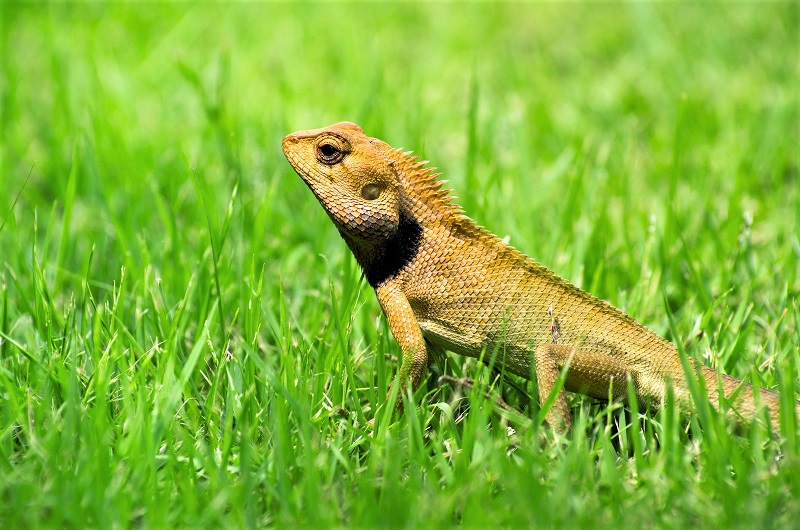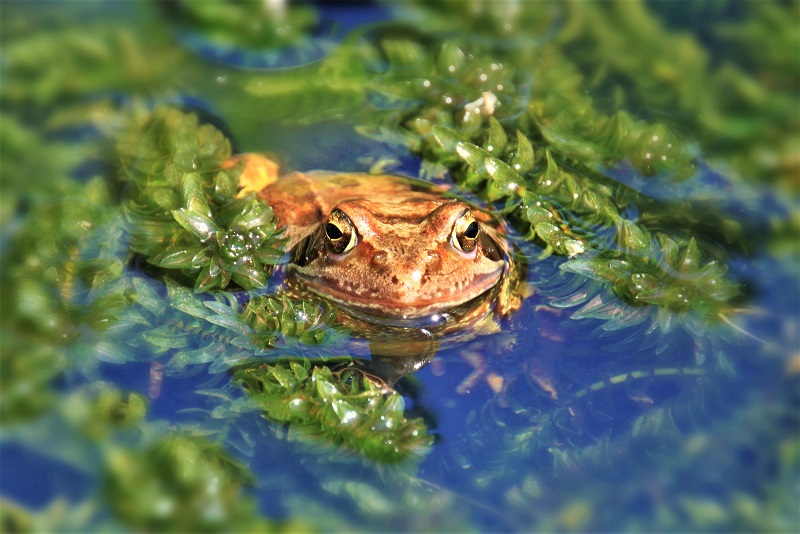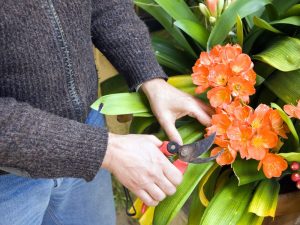Last Updated on June 21, 2024 by teamobn
Wildlife gardening is all the rage among gardeners today. Most of the attention goes to birds, butterflies, and beneficial insects. But an equally persuasive case can be made for enticing reptiles and amphibians into the garden.
Frogs, snakes, and lizards eat your garden’s worst enemies. They consume harmful insects, slugs, and other plant pests. Many are also food for other animals.

But while the snake, the lizard, and the toad can improve almost any garden, each is burdened by dwindling habitats. Like many other wild animals, their populations are declining.
Reptiles and amphibians are creatures from a faraway time, of wild open spaces, of countryside, of marshland, glades, and bogs. They don’t adapt well to changing conditions. They can’t survive on building sites and tarmac.
So, if some remain in the friendlier corners of your garden, you’d be wise to provide them with adequate shelter and protection with a hibernaculum. Whether you live on former reptile territory, it’s worth making your garden a haven for these wonderful animals.

Creating a Safe Haven for Snakes, Lizards, and Frogs
Contents
You can allow amphibians and reptiles a safe place to shelter through the cold of winter by building a hibernaculum. Hibernacula are small, subterranean chambers that amphibians and reptiles use to protect themselves from the winter chill.
The little, unobtrusive structure can also become a corner where solitary bees and birds can safely sun themselves.
The word “hibernaculum” is derived from the Latin word for winter, hibernus. Scientists argue over the semantics of whether reptiles and amphibians go into “dormancy,” “winter lethargy,” “brumate” or “hibernate.”
Most have accepted the general use of the term “hibernate” to describe the changes in behavior we observe in reptiles and amphibians in colder climates during the winter.

(Photo: Freddyfish4/Wikimedia Commons)
How to Build a Hibernaculum
Curiously, the best hibernacula are often unintended. Overgrown allotments with old plots mixed with soil, rubble, grass heaps, and other material make superb winter refuges. Tree roots, deep leave litter, compost heaps, log piles, and rock piles are also excellent over-wintering sites.
Below is how you can make your own Hibernaculum.
Materials
- Shovel
- Logs, branches, and twigs
- Bricks, stones, and rubble
- Corrugated drain pipes (optional)
- Soil and compost
- Native meadow seeds or grass
- Garden gloves
- Watering can or hose
Instructions
- Choose the Right Location
- Sunny and Elevated Spot: Select a location in your garden that receives ample sunlight and is slightly elevated to avoid waterlogging. Reptiles and amphibians prefer warm, dry spots for their hibernacula.
- Proximity to Water: Ideally, the site should be near a water source like a pond or a damp area that can provide hydration and a habitat during warmer months.
- Prepare the Site
- Clear the Area: Remove any debris, large rocks, or thick vegetation from the selected area. Mark out the space where you will dig.
- Size of the Hibernaculum: Plan for a hole approximately 1.5 meters wide and 50 centimeters deep. Adjust the size based on the available space and the number of reptiles and amphibians you expect to shelter.
- Dig the Hole
- Depth and Width: Dig a hole that is about 50 centimeters deep and 1.5 meters wide. The depth will help provide insulation and protection from the elements.
- Ensure Drainage: If the ground is prone to becoming waterlogged, consider adding a layer of gravel at the bottom for drainage.
- Layer the Base
- Log and Branch Layer: Place large logs, branches, and twigs at the bottom of the hole. This creates a strong foundation and spaces for animals to crawl into.
- Add Bricks and Stones: On top of the logs and branches, add a layer of bricks, stones, and rubble. These materials create gaps and crevices for smaller animals to hide.
- Create Entrances
- Natural Gaps: Ensure that the layers of logs, branches, and stones have enough gaps and openings for animals to enter.
- Optional Drain Pipes: Insert short sections of corrugated drain pipes horizontally at ground level as entrances. These pipes make it easier for animals to access the hibernaculum and stay safe from predators.
- Cover with Soil and Compost
- Layer Soil: Cover the pile with a mix of soil and compost. This layer should be about 50 centimeters thick. It provides additional insulation and stability.
- Shape the Mound: Form the soil into a gentle mound over the structure, ensuring it is compact enough to hold its shape but loose enough to allow for ventilation and water drainage.
- Plant Vegetation
- Sow Native Meadow Seeds: Scatter native meadow seeds or plant long grasses over the mound. This vegetation will attract pollinators in the summer and provide additional cover.
- Avoid Dense Planting: Ensure that the vegetation isn’t too dense, as this could restrict access for the reptiles and amphibians.
- Water the Area
- Initial Watering: Water the newly planted area lightly to help the seeds establish and encourage plant growth.
- Regular Maintenance: Keep the area watered as needed, especially during dry periods, to maintain the health of the plants and the moisture of the soil.
- Maintain the Hibernaculum
- Seasonal Checks: Inspect the hibernaculum periodically, especially before winter, to ensure it remains accessible and is not clogged with debris.
- Avoid Disturbance: During the winter months, avoid disturbing the hibernaculum as reptiles and amphibians will be hibernating inside.
- Vegetation Management: Trim any overgrown vegetation in the surrounding area as needed to keep the mound accessible.
- Enhance the Surrounding Area
- Add a Pond or Water Feature: Consider adding a small pond nearby to provide a water source and breeding ground for amphibians.
- Create Additional Shelters: Place rock piles, log stacks, or leaf litter nearby to offer more habitat options.

(Photo: Gareth Christian/Flickr)
Managing Your Garden Refuge
Creating a good hibernaculum is important, but your project will require suitable long-term management, as well. Try to create uneven margins around your site. Do not clear the vegetation over the mound. Instead, cut back on those verges where short grass turns into dense scrub.
Some areas may need cutting more often to prevent thistles and stinging nettles. But once suitable vegetation is established, you should cut even less.
Try not to mow your lawn in the late evening or at night. Practically all species of reptiles and amphibians move through the lawn at night. Even turtles become nocturnal during the egg-laying season, in early summer.
Consider installing a wildlife pond in your backyard. They are not too difficult to make and you don’t need a large pond if space is limited. With beautiful water lilies, a wildlife pond will bring you great enjoyment even as it provides a refuge for frogs and toads to lay eggs.
You can also convert part of your lawn into beautiful perennial flower beds, ground covers, or shrubs. An open lawn does not provide adequate protection for small animals. They occupy a rather low station on the food chain and often need to hide from predators.

Scientists estimate that 200 species of frogs have gone extinct since the 1970s. Many fear this is a harbinger for a far greater loss on the planet’s biodiversity.
In fact, some research suggests we’ll start seeing catastrophic declines in mammal, fish, and bird populations soon.
Following the rapid disappearance of various species of frogs, snakes, and lizards, many scientists now worry that these animals are the “most at-risk” among all vertebrates.
There is still time to turn the tide. Your garden can be part of the global effort to save what’s left of these precious creatures.
Integrating Hibernaculum with Other Garden Features
Creating a hibernaculum is a fantastic way to support local wildlife, especially reptiles and amphibians. However, to maximize its benefits, it’s essential to consider how a hibernaculum can be integrated into your broader garden design. By thoughtfully combining it with other garden features, you can create a diverse, wildlife-friendly environment that enhances the beauty and functionality of your outdoor space.
Combining Hibernaculum with Water Features
Water features, like ponds or small streams, are natural companions to a hibernaculum. Amphibians such as frogs and toads use water bodies for breeding and hydration. By placing a hibernaculum near a pond, you create a seamless transition between their summer and winter habitats.
Steps to Integrate:
- Proximity is Key: Position the hibernaculum close to your pond, ideally on a slightly elevated spot to prevent waterlogging during heavy rains.
- Connect with Native Plants: Plant moisture-loving vegetation around the pond and the hibernaculum to provide cover and attract insects, which serve as food for amphibians.
- Add Shallow Edges: Ensure your pond has shallow edges for easy access and exit for small animals moving between the water and the hibernaculum.
Enhancing with Natural Landscaping Elements
Integrating a hibernaculum with natural landscaping features like rockeries, log piles, and native plants can enrich the habitat and make your garden more attractive to wildlife. These elements offer additional hiding spots and basking areas for reptiles.
Steps to Integrate:
- Build a Rockery: Construct a rockery near the hibernaculum using various sizes of rocks and stones. This provides extra crevices for shelter and basking.
- Incorporate Log Piles: Add stacks of logs or wood piles nearby. Over time, these will decay and attract insects, creating a food source and additional refuge.
- Plant Native Species: Surround the hibernaculum with native plants and shrubs. These plants will provide year-round cover and help blend the structure into the landscape.
Merging with Flower and Vegetable Gardens
A hibernaculum can be an attractive and functional part of a flower or vegetable garden. Reptiles and amphibians help control pests naturally, reducing the need for chemical pesticides.
Steps to Integrate:
- Edge Planting: Plant flowering perennials or low-growing herbs around the hibernaculum. This not only beautifies the area but also attracts pollinators and beneficial insects.
- Companion Gardening: Use the hibernaculum’s proximity to plant pest-sensitive crops. Frogs and toads will help keep slug and insect populations in check.
- Create Pathways: Design garden paths that lead visitors to and around the hibernaculum. This makes it a focal point and an educational feature within the garden.
Incorporating with Wildlife Habitats
Your garden can support a variety of wildlife habitats. Combining a hibernaculum with birdhouses, bat boxes, and bee hotels creates a multi-functional refuge area that caters to different species.
Steps to Integrate:
- Cluster Habitats Together: Place birdhouses on trees or poles near the hibernaculum. This creates a compact wildlife area where various species can thrive together.
- Install Bat Boxes: Position bat boxes in higher locations near the hibernaculum to provide safe roosting sites for bats, which also help control insect populations.
- Add Bee Hotels: Attach bee hotels on garden fences or structures close to the hibernaculum. Solitary bees can use the hibernaculum as a sunny spot for warming up.
Integrating a hibernaculum with other garden features creates a vibrant, multifunctional space that supports a wide range of wildlife. This thoughtful approach not only enhances your garden’s beauty and biodiversity but also contributes to the broader effort of conserving local species. Embrace these strategies to make your garden a year-round haven for reptiles, amphibians, and other creatures.
Conclusion
For your reptile pets, creating a hibernaculum guarantees them a warm and secure haven to escape the winter months. It supports their hibernation needs by offering necessary warmth and shelter, much as in their native habitat. Building a well-planned hibernaculum improves their quality of life and supports their health and wellbeing.








